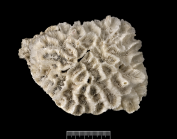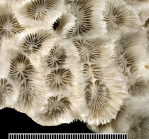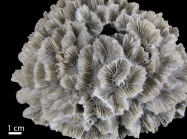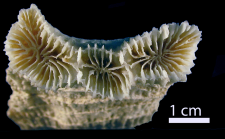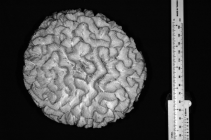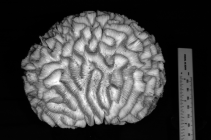WoRMS taxon details
Oulophyllia Milne Edwards & Haime, 1848
205663 (urn:lsid:marinespecies.org:taxname:205663)
accepted
Genus
Meandrina crispa Lamarck, 1816 accepted as Oulophyllia crispa Lamarck, 1816 (type by original designation)
Coelogyra Nemenzo, 1959 · unaccepted > junior subjective synonym
Erythrastrea Pichon, Scheer & Pillai, 1983 · unaccepted > junior subjective synonym
Ulophyllia Milne Edwards & Haime, 1857 · unaccepted > junior subjective synonym
- Species Oulophyllia bennettae (Veron, Pichon & Wijsman-Best, 1977)
- Species Oulophyllia crispa Lamarck, 1816
- Species Oulophyllia levis (Nemenzo, 1959)
- Species Oulophyllia wellsi (Ma, 1959)
- Species Oulophyllia aspera (Quelch, 1886) accepted as Oulophyllia crispa Lamarck, 1816 (unaccepted > junior subjective synonym)
- Species Oulophyllia cellulosa (Quelch, 1886) accepted as Oulophyllia crispa Lamarck, 1816 (unaccepted > junior subjective synonym)
- Species Oulophyllia spinosa Milne Edwards & Haime, 1849 accepted as Isophyllia sinuosa (Ellis & Solander, 1786) (unaccepted > junior subjective synonym)
marine, fresh, terrestrial
Milne Edwards, H.; Haime, J. (1848). Note sur la classification de la deuxième tribu de la famille des Astréides. <em>Comptes rendus hebdomadaires des séances de l'Académie des sciences, Paris.</em> 27: 490–497., available online at https://doi.org/10.5962/bhl.part.29692 [details]
Description 'Diffère du précédent [Tridacophyllia = Pectinia] par des murailles beaucoup moins élevées, par la présence d'une...
Description Colonies are massive, monocentric to meandroid, composed of large valleys with widely spaced, ragged septa and acute thin...
Description 'Diffère du précédent [Tridacophyllia = Pectinia] par des murailles beaucoup moins élevées, par la présence d'une columelle spongieuse bien marquée, et par des cloisons très-granulées dont le bord est très-profondément divisé, surtout inférieurement.' (Milne Edwards and Haime, 1848, vol. 27: 492) [details]
Description Colonies are massive, monocentric to meandroid, composed of large valleys with widely spaced, ragged septa and acute thin...
Description Colonies are massive, monocentric to meandroid, composed of large valleys with widely spaced, ragged septa and acute thin walls. Paliform lobes are usually present (Veron, 1986 <57>). [details]
Hoeksema, B. W.; Cairns, S. (2025). World List of Scleractinia. Oulophyllia Milne Edwards & Haime, 1848. Accessed through: World Register of Marine Species at: https://www.marinespecies.org/aphia.php?p=taxdetails&id=205663 on 2025-04-03
Date
action
by
2006-09-26 06:56:50Z
changed
Martinez, Olga
![]() The webpage text is licensed under a Creative Commons
Attribution 4.0 License
The webpage text is licensed under a Creative Commons
Attribution 4.0 License
Nomenclature
original description
Milne Edwards, H.; Haime, J. (1848). Note sur la classification de la deuxième tribu de la famille des Astréides. <em>Comptes rendus hebdomadaires des séances de l'Académie des sciences, Paris.</em> 27: 490–497., available online at https://doi.org/10.5962/bhl.part.29692 [details]
original description (of Ulophyllia Milne Edwards & Haime, 1857) Milne Edwards H, Haime J. (1857). Histoire naturelle des coralliaires ou polypes proprement dits 2. Librairie Encyclopédique de Roret, Paris. 631 pp., available online at https://www.biodiversitylibrary.org/page/12403706 [details]
original description (of Erythrastrea Pichon, Scheer & Pillai, 1983) Scheer, G. & Pillai, C.S.G. 1983. Report on the stony corals from the Red Sea. Zoologica, Stuttgart 45 (133): 1-198, pls. 1-41. [details]
original description (of Coelogyra Nemenzo, 1959) Nemenzo F (1959) Systematic studies on Philippine shallow water scleractinians: II. Suborder Faviida. Natural and Applied Science Bulletin, University of the Philippines 16: 73-135, pls. 1-24. [details]
basis of record Veron JEN. (1986). Corals of Australia and the Indo-Pacific. <em>Angus & Robertson Publishers.</em> [details]
original description (of Ulophyllia Milne Edwards & Haime, 1857) Milne Edwards H, Haime J. (1857). Histoire naturelle des coralliaires ou polypes proprement dits 2. Librairie Encyclopédique de Roret, Paris. 631 pp., available online at https://www.biodiversitylibrary.org/page/12403706 [details]
original description (of Erythrastrea Pichon, Scheer & Pillai, 1983) Scheer, G. & Pillai, C.S.G. 1983. Report on the stony corals from the Red Sea. Zoologica, Stuttgart 45 (133): 1-198, pls. 1-41. [details]
original description (of Coelogyra Nemenzo, 1959) Nemenzo F (1959) Systematic studies on Philippine shallow water scleractinians: II. Suborder Faviida. Natural and Applied Science Bulletin, University of the Philippines 16: 73-135, pls. 1-24. [details]
basis of record Veron JEN. (1986). Corals of Australia and the Indo-Pacific. <em>Angus & Robertson Publishers.</em> [details]
Other
context source (Hexacorallia)
Fautin, Daphne G. (2013). Hexacorallians of the World. (look up in IMIS) [details]
additional source Veron JEN. (2000). Corals of the World. Vol. 1–3. <em>Australian Institute of Marine Science and CRR, Queensland, Australia.</em> [details]
additional source Budd AF, Fukami H, Smith ND, Knowlton N. (2012). Taxonomic classification of the reef coral family Mussidae (Cnidaria: Anthozoa: Scleractinia). <em>Zoological Journal of the Linnean Society.</em> 166 (3): 465-529., available online at https://doi.org/10.1111/j.1096-3642.2012.00855.x [details]
additional source Matthai G. (1928). A Monograph of the Recent meandroid Astraeidae. <em>Catalogue of the Madreporarian Corals in the British Museum (Natural History).</em> 7: 1-288, pls. 1-72. [details] Available for editors [request]
[request]
additional source Cairns, S.D., R. Baron-Szabo, A.F. Budd, B. Lathuilière, E. Roniewicz, J. Stolarski & K.G. Johnson. (2010). Corallosphere. , available online at http://www.corallosphere.org [details]
additional source Huang D, Benzoni F, Fukami H, Knowlton N, Smith ND, Budd AF (2014) Taxonomic classification of the reef coral families Merulinidae, Montastraeidae, and Diploastraeidae (Cnidaria: Anthozoa: Scleractinia). Zoological Journal of the Linnean Society 171: 277–355., available online at https://doi.org/10.1111/zoj.12140 [details]
additional source Arrigoni R, Huang D, Berumen ML, Budd AF, Montano S, Richards ZT, Terraneo TI, Benzoni F. (2021). Integrative systematics of the scleractinian coral genera Caulastraea, Erythrastrea and Oulophyllia. <em>Zoologica Scripta.</em> 50(4): 509-527., available online at https://onlinelibrary.wiley.com/doi/abs/10.1111/zsc.12481 [details]
additional source Neave, Sheffield Airey. (1939-1996). Nomenclator Zoologicus vol. 1-10 Online. <em>[Online Nomenclator Zoologicus at Checklistbank. Ubio link has gone].</em> , available online at https://www.checklistbank.org/dataset/126539/about [details]
additional source Veron JEN. (2000). Corals of the World. Vol. 1–3. <em>Australian Institute of Marine Science and CRR, Queensland, Australia.</em> [details]
additional source Budd AF, Fukami H, Smith ND, Knowlton N. (2012). Taxonomic classification of the reef coral family Mussidae (Cnidaria: Anthozoa: Scleractinia). <em>Zoological Journal of the Linnean Society.</em> 166 (3): 465-529., available online at https://doi.org/10.1111/j.1096-3642.2012.00855.x [details]
additional source Matthai G. (1928). A Monograph of the Recent meandroid Astraeidae. <em>Catalogue of the Madreporarian Corals in the British Museum (Natural History).</em> 7: 1-288, pls. 1-72. [details] Available for editors
additional source Cairns, S.D., R. Baron-Szabo, A.F. Budd, B. Lathuilière, E. Roniewicz, J. Stolarski & K.G. Johnson. (2010). Corallosphere. , available online at http://www.corallosphere.org [details]
additional source Huang D, Benzoni F, Fukami H, Knowlton N, Smith ND, Budd AF (2014) Taxonomic classification of the reef coral families Merulinidae, Montastraeidae, and Diploastraeidae (Cnidaria: Anthozoa: Scleractinia). Zoological Journal of the Linnean Society 171: 277–355., available online at https://doi.org/10.1111/zoj.12140 [details]
additional source Arrigoni R, Huang D, Berumen ML, Budd AF, Montano S, Richards ZT, Terraneo TI, Benzoni F. (2021). Integrative systematics of the scleractinian coral genera Caulastraea, Erythrastrea and Oulophyllia. <em>Zoologica Scripta.</em> 50(4): 509-527., available online at https://onlinelibrary.wiley.com/doi/abs/10.1111/zsc.12481 [details]
additional source Neave, Sheffield Airey. (1939-1996). Nomenclator Zoologicus vol. 1-10 Online. <em>[Online Nomenclator Zoologicus at Checklistbank. Ubio link has gone].</em> , available online at https://www.checklistbank.org/dataset/126539/about [details]
 Present
Present  Inaccurate
Inaccurate  Introduced: alien
Introduced: alien  Containing type locality
Containing type locality
From editor or global species database
Comparison Oulophyllia is a moderately supported clade, and the singular synapomorphy is wall fusion, with a two-step change from moderate coenosteum to fused walls at its most recent common ancestor with Caulastraea. The genus is frequently associated with Favites and Platygyra, primarily because of their cerioid corallites (Vaughan and Wells, 1943: 169; Veron, 1986: 498, 2000, vol. 3: 195). The phylogeny based on both molecular and morphological evidence clearly shows this trait arising at least three times independently within Merulinidae, in the lineages represented by Favites + Platygyra, Coelastrea and Oulophyllia. The initial placement of Oulophyllia bennettae in Favites also underscores the homoplastic nature of this character (see remarks for Favites above). Another homoplastic character exemplified by this genus is corallite integration, which is polymorphic in this genus (uniserial in Oulophyllia crispa and O. levis; discrete in O. bennettae), Goniastrea and Platygyra. Among close relatives, these features may still be useful distinguishing characters, separating Oulophyllia from Caulastraea (phaceloid) and Pectinia + Mycedium (extensive coenosteum), as well as Oulophyllia and Caulastraea from Pectinia + Mycedium (organically united corallites). Few subcorallite characters are distinct for Oulophyllia within this clade, but a combination of medium tooth height (0.3–0.6 mm), more than 6 teeth per septum, palisade interarea and transverse septal crosses would be diagnostic. [details]Description 'Diffère du précédent [Tridacophyllia = Pectinia] par des murailles beaucoup moins élevées, par la présence d'une columelle spongieuse bien marquée, et par des cloisons très-granulées dont le bord est très-profondément divisé, surtout inférieurement.' (Milne Edwards and Haime, 1848, vol. 27: 492) [details]
Diagnosis Colonial, with intracalicular budding only. Corallites monomorphic and discrete (1–3 centers) or uniserial; monticules absent. Walls fused. Calice width medium (4–15 mm), with medium relief (3–6 mm). Costosepta confluent. Septa in 3 cycles (24–36 septa). Free septa present but irregular. Septa spaced < 6 septa per 5 mm. Costosepta equal in relative thickness. Columellae trabecular and spongy (> 3 threads), < 1/4 of calice width, and continuous among adjacent corallites. Paliform (uniaxial) lobes weak or moderate. Epitheca absent and endotheca abundant (vesicular). Tooth base at mid-calice circular. Tooth tip at mid-calice irregular; tip orientation perpendicular to septum. Tooth height medium (0.3–0.6 mm) and tooth spacing medium (0.3–1 mm), with > 6 teeth per septum. Granules scattered on septal face; irregular in shape. Interarea palisade. Walls formed by dominant paratheca; abortive septa absent. Thickening deposits fibrous. Costa center clusters not distinct; medial lines strong. Septum center clusters not distinct; medial lines strong. Transverse crosses present. Columella centers clustered. [details]
Remark Oulophyllia Milne Edwards and Haime, 1848, vol. 27: 492 is a small genus that has been recovered genetically as a well-supported clade (Fukami et al., 2004; Huang et al., 2009, 2011; but see Fukami et al., 2008; Arrigoni et al., 2012). It was established for the type species O. crispa, and compared to Pectinia as having lower walls and more spongy columellae (Milne Edwards and Haime, 1848, vol. 27: 492). The walls of Pectinia however refer to laminae that project upwards and may contain corallites formed by budding. Their corallites are organically united and thus the laminae may not be considered homologous to the walls of Oulophyllia, or other discrete or uniserial taxa. In spite of this, the two genera are indeed closely related, and together with Caulastraea and Mycedium form a well-supported molecular clade (Fukami et al., 2008; Huang et al., 2011; Arrigoni et al., 2012). Only Oulophyllia crispa and O. bennettae have been studied phylogenetically. The third species, O. levis, is very similar to the type in terms of macromorphology, differing only in having smaller valleys and less developed columellae (Veron, 2000, vol. 3: 198). In fact, it was originally described as having no columellae, with a 'loose mass of septal spines' in its place (Nemenzo, 1959: 109), thus expanding the morphological range specified by Milne Edwards and Haime, 1848, vol. 27: 492. [details]
Unreviewed
Description Colonies are massive, monocentric to meandroid, composed of large valleys with widely spaced, ragged septa and acute thin walls. Paliform lobes are usually present (Veron, 1986 <57>). [details]Remark Type species: Maeandrina crispa Lamarck, 1816 (Veron, 1986). [details]
To Biological Information System for Marine Life (BISMaL)
To European Nucleotide Archive, ENA (Erythrastrea) (from synonym Erythrastrea Pichon, Scheer & Pillai, 1983)
To European Nucleotide Archive, ENA (Oulophyllia)
To Genbank (from synonym Erythrastrea Pichon, Scheer & Pillai, 1983)
To Genbank
To ITIS
To European Nucleotide Archive, ENA (Erythrastrea) (from synonym Erythrastrea Pichon, Scheer & Pillai, 1983)
To European Nucleotide Archive, ENA (Oulophyllia)
To Genbank (from synonym Erythrastrea Pichon, Scheer & Pillai, 1983)
To Genbank
To ITIS
